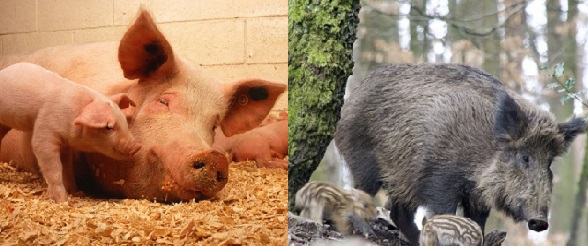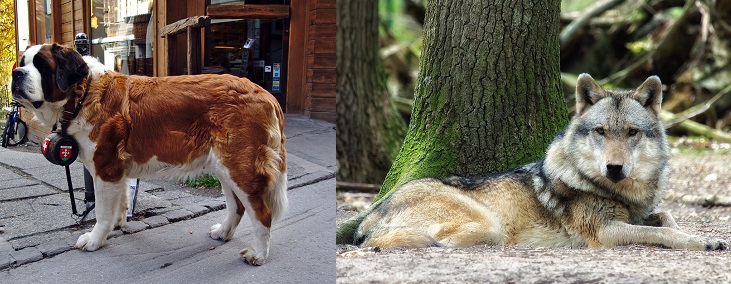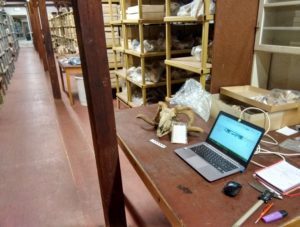
The multitude of varieties of domestic animals is astonishing. It seems natural that for example a short-nosed bulldog, a gracile Greyhound, and an enormous St. Bernard dog all belong to the same kind of organism, or species. And yet, domestic animals represent an extraordinary case of variation.
in relation to species in the wild, which may have evolved over millions of years, the first domestic animals are “only” 40,000 years old at most
This variation is staggering if one considers that it appeared in a relatively short period of time: in relation to species in the wild, which may have evolved over millions of years, the first domestic animals are “only” 40,000 years old at most. Going one step further, many of the extreme differences in skull shape that we may observe in domesticated animals today (e.g., extremely short noses in some dog breeds), are even more recent and the results of breeding practices in the last 200 years approximately. Also other traits of domesticates, such as grain yield in crops, milk production in cattle, or size of poultry may change greatly within only a few generations.
This has led to the assumption that the pace – or rate – of evolutionary change is greater in domestic organisms compared to wild ones, although a study has found that domestication does not lead to faster changes of characteristics in plants. In short, there is still a lot in the dark concerning rates of evolution in domestication. Therefore, my colleague Marcelo Sánchez-Villagra and I set out to fill a part of this gap. Principally, our goal was to compare evolutionary rates of change of skull dimensions in domestic vs. wild mammals, using dogs and pigs as case studies.

We gathered new and previously published data on skull dimensions in different domestic dog and pig breeds as well as populations of their wild relatives (wolves and wild boar) for comparison. For this, we went to museum collections and measured skulls from individuals which have died in different years (e.g., St. Bernard dogs from Switzerland from the years 1885 – 2012).These were mostly simple, linear measurements for which we used callipers (Fig. 1).

Figure 1. This is how a typical day of taking measurements in a museum collection looks like (although this is not an example of the current study, but it is basically the same): hundreds of specimens wait in their boxes and drawers to be discovered and measured. Linear measurements of different skull dimensions are then taken with callipers and documented in data tables.
We then calculated (using statistical regressions) if these measurements got smaller or larger over time, i.e., from the oldest to the most recent skull, or if there were no directed changes at all. The magnitude of these changes are the evolutionary rates, or in other words, the amount of change over time. In a further step, we calculated if these evolutionary rates were larger, smaller, or similar in the domestic vs. the wild mammals.
We also compared our estimated evolutionary rates to previously published ones from the literature. These data included traits other than skull dimensions in species other than dogs and pigs: e.g. change of racing speed in greyhounds and horses or change of backfat thickness in pigs.
Our analyses showed that most skull dimensions do not change faster in domesticated breeds than in wild populations, i.e., the evolutionary rates are similar in wild and domestic pigs and dogs. This result was surprising, given the extensive changes of skull form in some dog breeds throughout the last decades (Fig. 2). Evolutionary rates of traits other than skull dimensions (e.g., racing speed in horses and greyhounds) vary greatly with species and breeding aim and were found to be faster as well as slower compared to evolutionary rates in wild populations.

Figure 2 illustrates the change of one of the skull measurements throughout many decades in two domestic dog breeds: the two white bars on the photographs show the plane of the snout and the braincase, respectively, and a trend towards dorsal bending of the snout in the St. Bernard and ventral bending in the bullterrier.

To conclude, our study shows that evolutionary rates in domestication are not in any event faster than those in the wild, although they are often perceived as such given the vast changes that appear in a relatively short period of time. This may imply that evolution under natural conditions – i.e., without human intervention – is not as slow as previously described. In any event, it is clear that rates of evolution vary among species and situations, and quantifying them should give us insights into how fast or slow evolutionary transformations do occur, and thus address one of the fundamental questions posed by Darwin.
Dr. Madeleine Geiger
Latest posts by Dr. Madeleine Geiger (see all)
- The pace of evolution in domestication - 24th May 2018
Comments